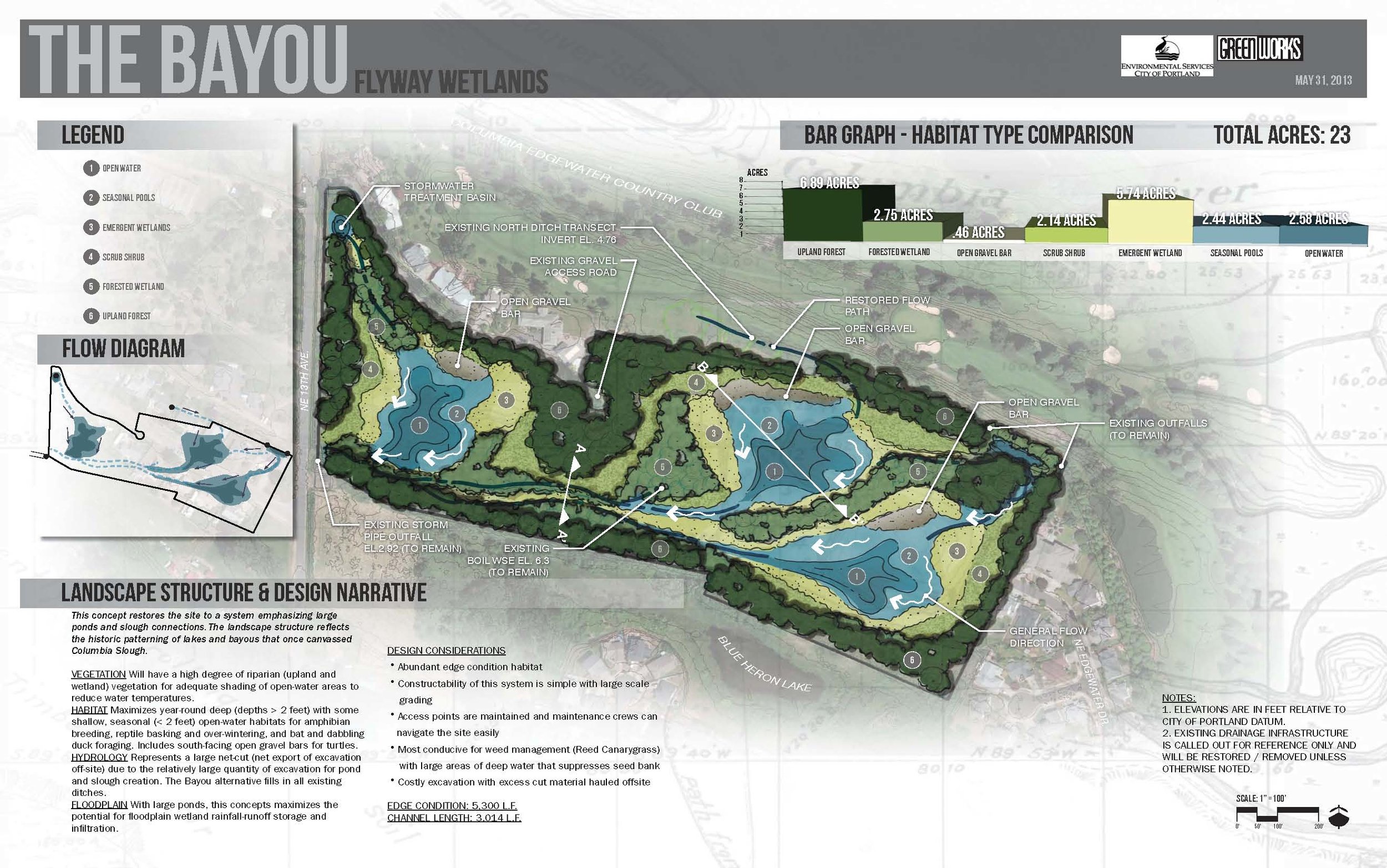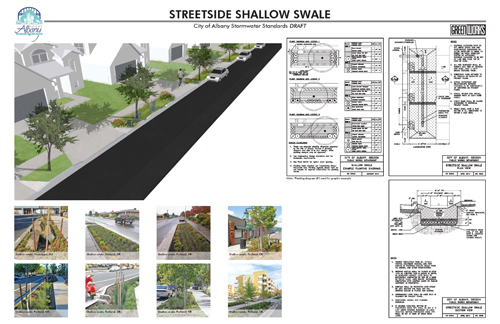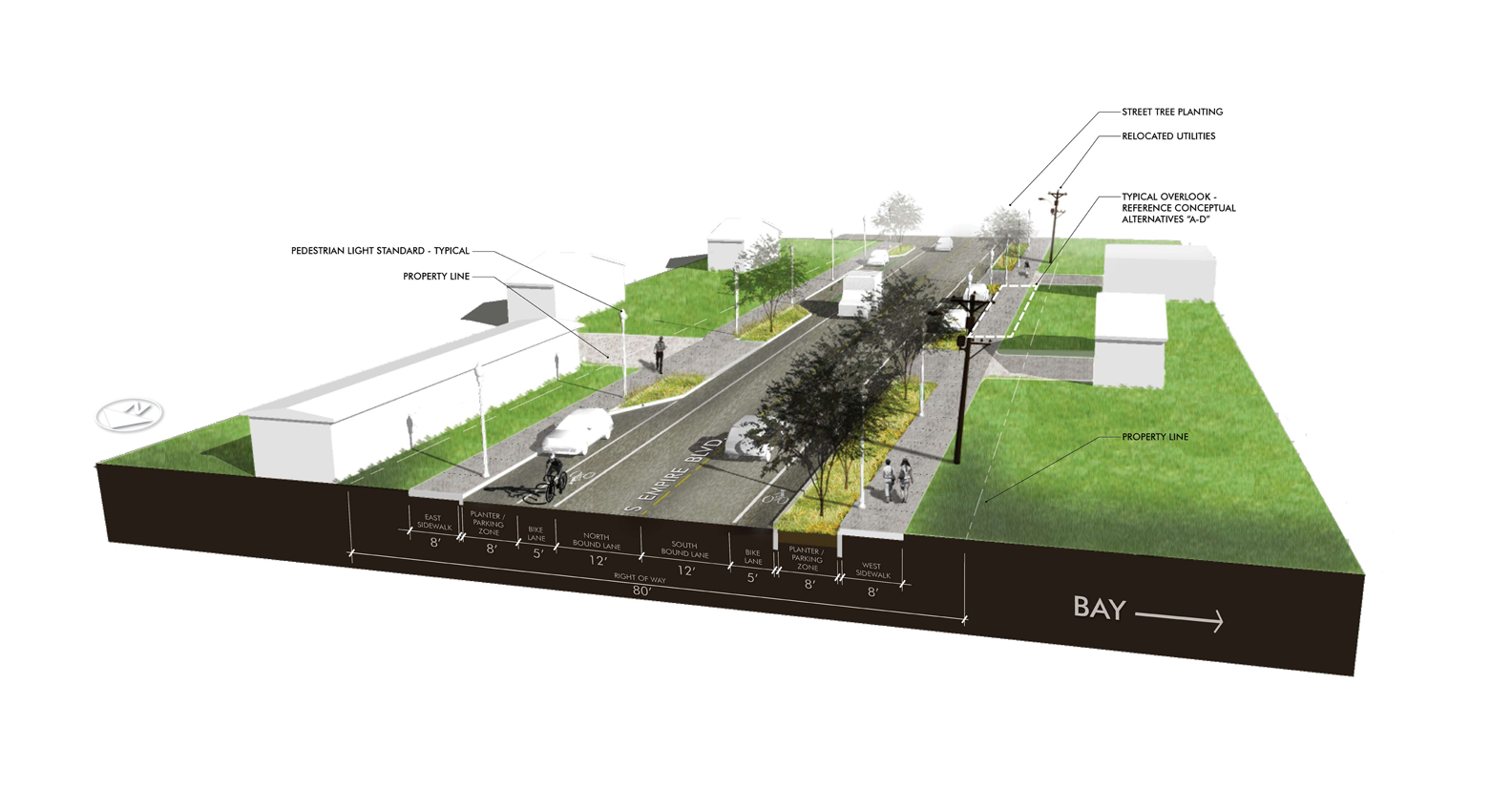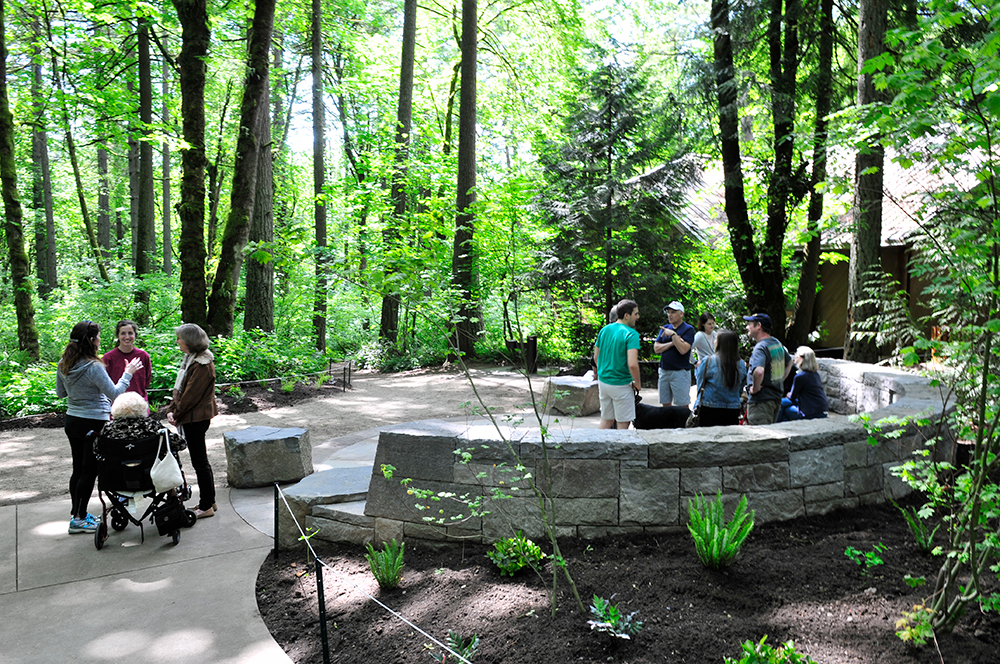CWS Low Impact Development Handbook
/To view the complete handbook visit the link below.
To view the complete handbook visit the link below.


In November of 2014 GreenWorks began a site assessment and preliminary design for the Johnson Creek Oxbow Enhancement Project. The central feature of the site is the namesake “Oxbow” meander, which is bounded on the south by a bypass channel that truncates the oxbow creating an island. The by-pass channel was constructed by the Works Progress Administration (WPA) in the 1930’s and included armoring the creek bed and banks, and creating a fish ladder in the oxbow to maintain fish passage. The goal of the WPA work was to convey flood flows efficiently downstream. It resulted in a confined channel, which is hydrologically disconnected from adjacent floodplains and wetlands, and exacerbates flooding. GreenWorks was charged with providing design strategies for improving floodplain hydrology, riparian and in-stream habitat, and local flood impacts.
To support these goals, GreenWorks held a one day charrette, which included members from BES, ESA-Vigil Argimis, and KPFF to discuss and recommend a variety of design strategies for improving the inherent conditions found within the Johnson Creek Oxbow. Recommendations were collected and vetted amongst the consultants and further discussed with BES to determine a set of design alternatives for specific sites within the project area. Project sites were mapped, along with support graphics and images, and cost-estimates, to BES in a comprehensive Pre-Design report, thus allowing BES to prioritize future improvement projects for the Johnson Creek Oxbow area.

GreenWorks provided landscape architecture services for Portland’s Bureau of Environmental Services Flyway Wetland property located between the Columbia Slough and the Columbia River near the Portland airport. GreenWorks led a team to provide several wetland restoration concepts and a wetland delineation report. GreenWorks headed several workshops with the consultant and team to develop the preferred concepts based on goals for the project including: water quality improvement; vegetation and habitat restoration; wetland hydrology improvement; and floodplain wetland hydrology improvements. Wetland and Stream Delineation Reports and Wetland Restoration Concepts were created for internal analysis related to bureau’s goals for restoring the site and their overarching restoration goals for bureau’s environmental group.







In January 2010, GreenWorks and BES staff conducted intensive field work locating and documenting potential locations for stormwater facilities throughout the Columbia Slough Watershed in North Portland. The Columbia Slough has been designated a high priority area by the City of Portland for improving watershed health and reducing pollutants. The project team focused on four target areas where green street facilities would maximize stormwater quality treatment and capture contaminated sediment before being discharged into the Slough. Each potential green street facility was ranked based on its potential performance, feasibility, and cost. GreenWorks assisted BES in project prioritization and provided an overall ranking using Geographic Information Systems (GIS). Over 150 potential green street facilities were identified, which would potentially result in stormwater treatment from over 35 acres of impermeable surfaces.




GreenWorks has worked over the past several years with City of Albany staff to develop stormwater quality standards for development to meet DEQ regulatory requirements. The products include new and updated sections of City Administrative Codes, Development Codes, Engineering Standards, Standard Construction Specifiations, and Standard Drawings. The draft products are currently in the public review process, with adoption and implementation tentatively planned by the end of 2014. Draft documents are all available for review on the City of Albany/Public Works/Engineering web page.



GreenWorks provided landscape architectural design services for Chown Pella, located in the heart of Portland’s historic Pearl District. The landscape features for this 75 loft housing condominium and retail space development consisted of fencing, parking, street tree plantings and seating areas.

The Madrona Lofts in the Rose Quarter of Portland offered a tremendous opportunity to rehabilitate an older hotel into much needed housing complex. GreenWorks was part of a team of designers that analyzed the existing facilities and surrounding development for opportunities to improve both the project site and the pedestrian connections from the community, through the site, to the adjacent Rose Garden.
Applying a number of sustainable site design practices, GreenWorks provided designs focused on developing meaningful pedestrian spaces and strengthening pedestrian connections to the surrounding developments.

The City of Coos Bay received federal funding to install bike lanes, landscape strips, and sidewalks to Empire Boulevard between Newmark Avenue and Wisconsin Avenue to provide alternative transportation opportunities along this heavily traveled corridor.
Improvements include widening the existing two-lane road to make room for on-street parking and bike lanes, installing curb, gutter, landscape strips with street trees, and sidewalk on both sides of the road. Stormwater / water quality facilities are constructed to manage stormwater on-site, converting Empire Boulevard into a ‘green street’. Other project elements include interpretive overlooks with site furniture, illumination, signing, striping, and numerous driveway connections.

GreenWorks participated in a series of volunteer design sessions, focused on improving the entry, arrival sequence and wayfinding for visitors to SW Portland’s Tryon Creek State Park.

GreenWorks participated in a series of volunteer design sessions, focused on improving the entry, arrival sequence and wayfinding for visitors to SW Portland’s Tryon Creek State Park. In concert with Fletcher Farr Ayotte Architects, we assisted in evaluating existing circulation patterns for pedestrians, bicyclists and drivers who access and use the park. The result of this effort was a series of site planning and design recommendations to both Oregon Parks and Recreation Department staff and the Friends of Tryon Creek.



With the completion of the Big Pipe in 2011, water quality in the Willamette has improved by leaps and bounds. In the wake of this achievement, Will Levenson, head of the non-profit Human Access Project, is leading an effort to change people’s perceptions of the river and encourage recreation in the water and along the waterfront.
GreenWorks became involved in the Human Access Project in November 2012, bringing our extensive experience designing places for people within sensitive natural environments, which focus on balancing access with habitat conservation.
This balance is certainly a key consideration as the Human Access Project gains momentum through additional community outreach and scaled interventions along the Willamette’s shores. Greenworks is honored to be contributing to this worthy cause and looks forward to witnessing the transformation of Portland’s largest public open space in the years to come.
Integrating people and nature through creative and sustainable design.
Landscape Architecture | Environmental Design
110 SE Main St, Suite 100, Portland, OR 97214
e. info@greenworkspc.com p. 503.222.5612 f. 503.222.2283